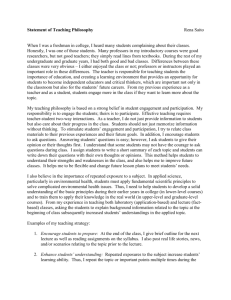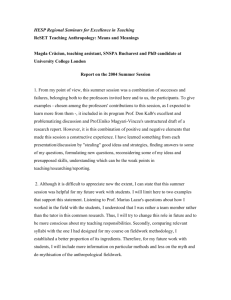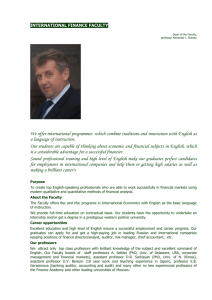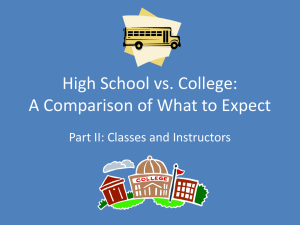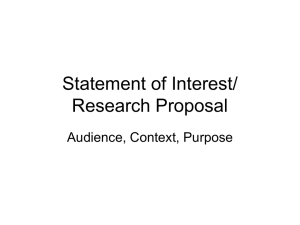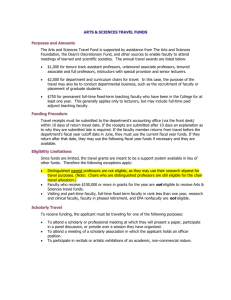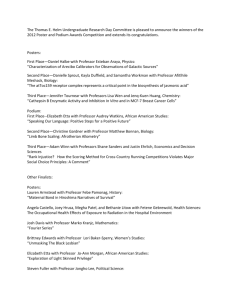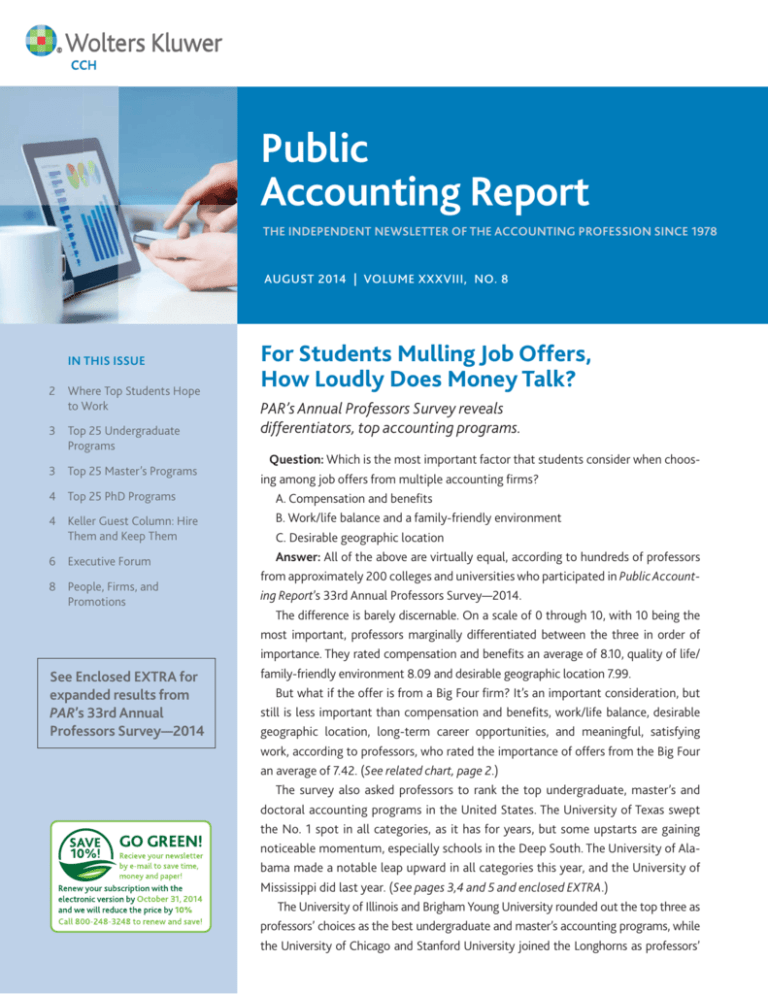
Public
Accounting Report
THE INDEPENDENT NEWSLETTER OF THE ACCOUNTING PROFESSION SINCE 1978
AUGUST 2014 | VOLUME XXXVIII, NO. 8
IN THIS ISSUE
2 Where Top Students Hope
to Work
3 Top 25 Undergraduate
Programs
3 Top 25 Master’s Programs
4 Top 25 PhD Programs
4 Keller Guest Column: Hire
Them and Keep Them
6 Executive Forum
8 People, Firms, and
Promotions
See Enclosed EXTRA for
expanded results from
PAR’s 33rd Annual
Professors Survey—2014
October 31, 2014
October 31, 2014
For Students Mulling Job Offers,
How Loudly Does Money Talk?
PAR’s Annual Professors Survey reveals
differentiators, top accounting programs.
Question: Which is the most important factor that students consider when choosing among job offers from multiple accounting firms?
A. Compensation and benefits
B. Work/life balance and a family-friendly environment
C. Desirable geographic location
Answer: All of the above are virtually equal, according to hundreds of professors
from approximately 200 colleges and universities who participated in Public Accounting Report’s 33rd Annual Professors Survey—2014.
The difference is barely discernable. On a scale of 0 through 10, with 10 being the
most important, professors marginally differentiated between the three in order of
importance. They rated compensation and benefits an average of 8.10, quality of life/
family-friendly environment 8.09 and desirable geographic location 7.99.
But what if the offer is from a Big Four firm? It’s an important consideration, but
still is less important than compensation and benefits, work/life balance, desirable
geographic location, long-term career opportunities, and meaningful, satisfying
work, according to professors, who rated the importance of offers from the Big Four
an average of 7.42. (See related chart, page 2.)
The survey also asked professors to rank the top undergraduate, master’s and
doctoral accounting programs in the United States. The University of Texas swept
the No. 1 spot in all categories, as it has for years, but some upstarts are gaining
noticeable momentum, especially schools in the Deep South. The University of Alabama made a notable leap upward in all categories this year, and the University of
Mississippi did last year. (See pages 3,4 and 5 and enclosed EXTRA.)
The University of Illinois and Brigham Young University rounded out the top three as
professors’ choices as the best undergraduate and master’s accounting programs, while
the University of Chicago and Stanford University joined the Longhorns as professors’
2
PUBLIC ACCOUNTING REPORT
picks for the top three accounting doctoral programs.
The universities of Mississippi, Alabama and Florida took
the top three undergraduate spots for schools with 16 to
21 accounting faculty, and the University of Virginia, North
Carolina State University and College of William & Mary
took top three honors for undergraduate accounting programs with 15 or fewer faculty.
At the master’s degree level, the universities of Michigan, Alabama and Florida topped the list for accounting
programs with 16 to 21 faculty. For master’s accounting
programs with 15 or fewer faculty, the University of Virginia, North Carolina State University and Vanderbilt University claimed the top three spots.
Look for expanded information and additional results
from Public Accounting Report’s 33rd Annual Professors Survey—2014 in the enclosed EXTRA and in future issues of PAR. ■
Public Accounting Report
Differentiators Students Consider
in Accepting Job Offers
Public Accounting Report
Public Accounting Report’s 33rd Annual Professors
Survey—2014 asked professors the following question:
“Upon graduation, at which CPA firm or corporation does/
did your top accounting student this year hope to work?
Following are their answers.
Many accounting students face the enviable dilemma of choosing
between job offers. Professors were asked to rank, based on their
own perceptions, the relative importance of the following factors
to students who are deciding between job offers. They ranked on
a scale of 0 to 10, with 0 being “Not important at all” and 10 being
“Most important.” The table below illustrates the average rankings.
EY
25.3%
Compensation and benefits
8.10
PwC
23.6%
Quality of life/family-friendly environment
8.09
Deloitte
16.3%
Desirable location/geographic base
7.99
KPMG
12.2%
Long-term career opportunities
7.84
Any Big Four
12.3%
Meaningful/satisfying work
7.61
Any Top 7 Global Firm
2.2%
Whether the offer is from a Big Four firm
7.42
Other Accounting Firm*
2.1%
Knowing peers at the firm
6.56
Pursuing Additional Education
0.5%
Client service reputation
6.38
Major Consulting Firm
1.1%
Firm’s long-term business outlook
6.22
Corporate America
2.0%
Technical reputation
6.21
Major Wall Street Firm
0.8%
Access to latest technology
6.1 7
Other
1.6%
Knowledge/acquaintance with partners
or other authority figures at the firm
6.03
Workplace diversity
5.28
Other*
1.94
* Firms specifically cited by professors were BKD LLP, based in Springfield, Mo.; Baker
Newman & Noyes, based in Portland, Maine; Carr Riggs Ingram, based in Enterprise,
Ala.; CliftonLarsonAllen, based in Minneapolis; Frost PLLC, based in Little Rock, Ark.;
Hess, Stewart & Campbell, based in Huntington, W.Va.; Jackson Thornton, based in
Montgomery, Ala.; Montana-based JCCS PC; Lee Gray CPA of Amite City, La.; Plante
Moran, based in Southfield, Mich.; RubinBrown, based in St. Louis; Sikich LLP, based in
Naperville, Ill.; Smith, Dukes & Buckalew, based in Mobile, Ala.; and Warren Averett, based
in Birmingham, Ala. Source: Public Accounting Report 33rd Annual Professors Survey—2014
* Among other factors of significance noted were opportunity to practice desired
specialty, travel demands and firm’s perceived ethical reputation. Source: Public
Accounting Report 33rd Annual Professors Survey—2014
PUBLIC ACCOUNTING REPORT
THE INDEPENDENT NEWSLETTER OF THE ACCOUNTING PROFESSION SINCE 1978
Editor
Julie Lindy
julie.lindy@wolterskluwer.com
Senior Contributing Editor
Bryan Powell
bryanpowell.par@gmail.com
Contributing Editors
Tony Powell
tony.powell@wolterskluwer.com
Sandra Lim
sandra.lim@wolterskluwer.com
Production Editor
Don Torres
Managing Editor
Terry Vaughan
Coordinating Editor
Jim Walschlager
CCH Journals and Newsletters
PUBLIC ACCOUNTING REPORT (ISSN 0161-309X) is published monthly by CCH, a part of
Wolters Kluwer, 4025 W. Peterson Ave., Chicago, Illinois 60646. Subscription inquiries should
be directed to 4025 W. Peterson Ave., Chicago, IL 60646.
Phone: 800.449.8114 | Fax: 773.866.3895 | Email: cust_serv@cch.com
Permissions requests: Requests for permission to reproduce content should be directed to CCH,
permissions@cch. com.
Photocopying or reproducing in any form in whole or in part is a violation of federal copyright law and
is strictly forbidden without the publisher’s consent. No claim is made to original governmental
works; however, within this product or publication, the following are subject to CCH’s copyright:
(1) the gathering, compilation, and arrangement of such government materials; (2) the magnetic
translation and digital conversion of data, if applicable; (3) the historical, statutory, and other notes
and references; and (4) the commentary and other materials.
Email Alert for the Current Issue
Sign Up Here...
CCHGroup.com/Email/Journals
VOLUME XXXVIII, NO. 8
©2014 CCH Incorporated. All Rights Reserved.
AUGUST 2014 | VOLUME XXXVIII, NO. 8
Public Accounting Report
Public Accounting Report
33rd Annual Professors Survey—2014
33rd Annual Professors Survey—2014
Top 25 Undergraduate Programs
Top 25 Master’s Rankings
2014
2013
1
1
2
School
2014
2013
University of Texas
1
1
University of Texas
2
University of Illinois
2
3
University of Illinois
3
3
Brigham Young University
3
2
Brigham Young University
4
5
University of Notre Dame
4
4
University of Notre Dame
5
6
University of Southern California
5
6
University of Southern California
6
4
University of Mississippi
6
7
University of Michigan
7
7
Texas A&M University
7
8
Texas A&M University
8
23
University of Alabama
8
26
University of Alabama
9
8
Indiana University
9
14
University of Georgia
10
11 (T)
University of Georgia
10
9
Indiana University
11
9
University of Florida
11
13
University of Florida
12
10
The Ohio State University
12
11
University of Missouri
13
17
University of Wisconsin
13
20
University of Wisconsin
14
13
Michigan State University
14
12
The Ohio State University
15
11 (T)
University of Missouri
15
10
University of North Carolina
16
14
University of Pennsylvania
16
15
Michigan State University
17
18
Miami University (Ohio)
17
5
University of Mississippi
18
21
University of Virginia
18
23
University of Virginia
19
19 (T)
University of Washington
19
21
University of Washington
20
28
New York University
20
17
Wake Forest University
21
19 (T)
Wake Forest University
21
25
Arizona State University
22
24
University of Tennessee
22
28
University of Iowa
23
15
CUNY—Baruch College
23
24
University of Tennessee
24
25 (T)
Penn State
24
34 (T)
Penn State
25
35 (T)
North Carolina State University
25
39 (T)
University of Arizona
For the complete list of the 2014 Top 50 undergraduate
accounting programs, see enclosed EXTRA! Note: Some schools
listed may offer variations to traditional bachelor’s degrees in
accounting, such as concentrations and integrated degrees.
All schools are main campus unless otherwise indicated.
(T) = Tie Source: PAR research based on professors rankings of
accounting programs at U.S. colleges and universities. Survey was
conducted during April and May 2014.
School
For the complete list of the 2014 Top 50 master’s accounting
programs, see enclosed EXTRA! Note: Master’s degrees in accounting
and integrated degrees only; does not include MBAs. All listings
are main campus unless othewise indicated. (T) = Tie. Source: PAR
research based on professors’ rankings of accounting programs at
U.S. colleges and universities and published accounting department
faculty data. Survey was conducted in April and May 2014.
3
4
PUBLIC ACCOUNTING REPORT
Public Accounting Report
33rd Annual Professors Survey—2014
Top 25 PhD Programs
GUEST COLUMN
2014
2013
1
1
University of Texas
When Talent Walks Out
the Door, a Huge New
Investment Walks In
2
3
University of Chicago
Keep the talent, keep the ROI.
3
2
Stanford University
4
5
University of Illinois
5
4
University of Michigan
6
6
University of Pennsylvania
7
7
University of North Carolina
8
10
Texas A&M University
9
8
University of Mississippi
10
9
University of Washington
11
11
Michigan State University
12
24
University of Alabama
13
12
Indiana University
14
21 (T)
Cornell University
15
15
University of Iowa
16
14
University of Georgia
17
13
University of Southern California
18
23
University of Wisconsin
19
25
University of Arizona
20
16
University of Missouri
21
19
University of Florida
22
18
Penn State
23
21 (T)
24
20
Harvard University
25
17
The Ohio State University
School
Massachusetts Institute of Technology
(T) = Tie Source: PAR research based on professors’ rankings of
accounting programs at U.S. colleges and universities that offer
doctoral degrees in accounting. Survey was conducted during
May and June 2014.
By Rita Keller
Founder, Keller Advisors LLC
and Co-Founder, SurveyCPA
I receive many questions regarding these two words:
Turnover Costs. How much does it really cost to replace a
lost employee?
When you research this question, you will find that the
results of the studies are all over the board.
Here are some estimates of turnover costs that might
give you an idea and also be helpful for your clients. Keep
in mind that your clients are trying to keep people, too.
This information comes from a study by the Center For
American Progress:
16% of annual salary for high-turnover, low-paying jobs
(earning under $30,000 a year). For example, the cost to
replace a $10-per-hour retail employee would be $3,328.
20% of annual salary for mid-range positions ($30,000
to $50,000). A $40,000 employee would cost $8,000
to replace.
Up to 213% of annual salary for highly educated executive positions. By the way, CPAs at various levels are
all highly educated positions. A $100,000 manager x
213% = $213,000.
One of the problems with determining turnover costs is
the fact that employers, including accounting firms, do not
track the detailed costs very well, if at all. According to Josh
Bersin, founder of Bersin by Deloitte, the following factors
should be considered in calculating the real cost of losing
an employee:
The cost of hiring a new employee including the advertising, interviewing, screening and hiring.
Cost of on-boarding a new person, including training
and management time.
Lost productivity. It may take a new employee one to
two years to reach productivity of an existing person.
AUGUST 2014 | VOLUME XXXVIII, NO. 8
Lost engagement. The other employees who see high
turnover tend to disengage and lose productivity.
Customer service and errors. For example, new employees
take longer and are often less adept at solving problems.
Training cost. For example, over two to three years, a
business likely invests a minimum of 10% to 20% of an
employee’s salary in training.
Cultural impact. Whenever someone leaves, others
take time to ask, “Why?”
The best accounting firms are focused on reducing turnover
costs, but more importantly, they are focused on keeping top
performers to provide for firm succession. They accomplish
this goal by taking positive steps to engage their employees.
According to the Gallup organization, employers have
three types of employees:
Engaged employees work with passion and feel a profound connection to their firms. They drive innovation
and move the organization forward.
Not-engaged employees are essentially “checked-out.”
They’re sleepwalking through their workday, putting in
time—but not energy or passion—into their work.
Actively disengaged employees aren’t just unhappy at
work—they’re busy acting out their unhappiness. Every
day, these workers undermine what their engaged coworkers accomplish.
I have observed that leaders in many accounting firms fail
to implement initiatives that go a long way in supporting and
retaining their engaged employees (top talent). Many accounting firms also lack the commitment to outplace the actively
disengaged employees. Your best performers expect you to get
your poor performers out of the way.
The talent wars are back, and the shortage in the accounting profession is real. A recent article in Crain’s Detroit Business titled “Demand for accountants brings rising
salaries, signing bonuses” notes:
Some accounting firms, including Plante Moran, based
in Southfield, Mich., pay referral bonuses to current
staff of up to $5,000 to help lure a CPA.
Many firms wine and dine top candidates, tour them around
beautiful neighborhoods or take them to sporting events.
Signing bonuses have returned, and more and more firms,
such as Yeo & Yeo, based in Saginaw, Mich., are offering
them so they can compete with the large national firms.
These kinds of activities and
many more are happening in every
area of the country. This summer, at
various conferences and meetings
involving multiple firms, I have asked
audiences, “How many of your are
actively hiring?” Hands go up from
almost every person in the audience. Rita Keller
“It’s a candidate-short market,”
says Robin Ankton, regional vice president at Robert Half
International. “If you want a candidate, you have to move
very quickly. Accounting is very, very hot.”
In addition to referral bonuses and hiring bonuses, perks
that were offered during the talent wars of 2000 to 2007
are re-emerging. When the economy dived in 2008, many
of them were eliminated.
Savvy practitioners have also identified the millennials’
wants and needs, which include:
Enhanced mentoring programs. Mentoring has evolved.
It now includes multi-levels. Be sure your program
includes these levels: Guide (or Buddy), Coach,
Mentor and Sponsor. There are different needs for
various levels of experience.
Reduced travel. It may have started with the millennials, but these days, almost every professional wants
more life/work balance.
More money. Some employees enjoy the monetary
benefits, and firms are paying overtime for salaried
professionals working additional hours during the
peak times.
More time off. Other employees desire an extra week
of vacation, more holidays or four-day workweeks during the summer months. I have talked to many firms
this year that close the office on Fridays beginning May
1 through at least Labor Day. A few keep the four-day
schedule until Dec. 31.
Speed of advancement. Provide more titles (levels) so
that young people can chart their progress on a faster
track. Give them a bonus after 90 days—it could simply
be a week’s vacation.
Virtual work opportunities. Accounting firms have discovered that remote connectivity and cloud options
enable them to keep employees who must move away
5
6
PUBLIC ACCOUNTING REPORT
for personal reasons or who do not live near the firm’s
office. Providing access to the firm’s systems whenever
and wherever is a must.
Continual communication. Millennials want to be
“in” on things from the beginning of their careers.
Often, they are left out of the communication loop
inside firms. They have helicopter parents who included them in discussions and decisions since they
were toddlers. In an accounting firm, they often receive too much silence.
In my opinion, two more things are very important in
retaining top talent inside an accounting firm. They are:
(1) Well-trained, supportive, nurturing, hands-on managers.
According to Gallup, 70% of people leave a job because
of their direct supervisor. In an accounting firm, that
means the partners and managers, most of whom have
never received any training or education on how to effectively manage people.
(2) Clearly defined and documented career tracks. Accounting firms hire many young people just beginning their
accounting careers. These young people want to know
where they are going and how they can get there. So
many firms do not have a documented guide that explains the path to partnership.
As you develop improved hiring and retention strategies at
your accounting firm, keep in mind these two two-word phrases:
Hire right. Keep them.
Rita Keller, one of the most well-known authorities on accounting firm management, acts as advisor and coach to accounting firm leaders nationwide. She can be contacted at
rkeller@ritakeller.com. ■
EXECUTIVE FORUM
How Does the ACA Affect Your Firm? Accounting Firm Execs
Reveal Their Insights
Leaders mull options and opportunities as the clock ticks and the political chess match continues.
Many accounting firms see the Affordable Care Act (ACA) as an
opportunity to help their clients and offer additional services. But it
affects all employers, including accounting firms. This month, PAR
asked accounting firm executives, “What effect is the ACA having—or will it have—on your own firm?”
Dave Stende, CEO/managing
partner, Eide Bailly/Fargo, N.D.
(FY14 net revenue: $192 million;
204 partners, 1,210 total staff, 24
offices):
We implemented a wellness
initiative four years ago, which has
had an incredible impact on controlDave Stende
ling our premiums for the past four
years. We do not anticipate any changes in full-time versus
part-time status, except where it makes sense for work/life
balance needs. And we will continue to keep an eye on the
exchanges to see how healthcare decisions are being made.
From an external client perspective, Eide Bailly has Health
Care Reform Champions in every office—thought leaders who
are helping clients make informed decisions. We provide education, analytics and advice to help our clients look at their
specific situation and make a decision that fits their needs. We
anticipate hiring additional staff to help clients with the reporting requirements surrounding healthcare reform, including tracking employee status and tax filing requirements.
Bruce Benator, managing partner, Williams Benator & Libby/Atlanta (FY13 net revenue: under $10
million; six partners, 35 total staff):
The most significant impact of
the ACA for the firm has been and
will be increased premiums from
our insurance carrier. Additionally,
Bruce Benator
the ACA has mandated some plan
design changes that are more costly to insurance carriers. Our
plans have always exceeded the minimum value standard, so
we have experienced limited design changes due to the ACA.
AUGUST 2014 | VOLUME XXXVIII, NO. 8
Going forward, as healthcare costs continue to rise, it is inevitable that our employees will feel an impact, but we are
committed to making every effort to keep the additional costs
passed to employees to a minimum. We don’t anticipate the
ACA having any effect on our staffing or HR considerations.
Our clients, for the most part, are turning to their insurance
agents for help with the ACA, and we have not had a lot of
opportunity for additional services. We have participated in
panel discussions on the income tax and other changes for
certain industry groups, have answered questions on Health
Savings Accounts and the timing of plan changes, and we have
provided some benchmarking information to our clients.
Darci Congrove, managing director, GBQ Holdings LLC/Columbus, Ohio (FY13 net revenue: $21.9
million; 17 partners, 135 total staff,
five offices):
This year, for the first time ever,
GBQ experienced a rate increase on
our health insurance that was starDarci Congrove
tling: 34.7%. In the last 10 years, as
part of a multi-employer pool, our annual increases have ranged
between 0% and 12%. Our associates are almost all full time
and eligible for health insurance benefits. We do not have any
plans to change the way we hire or structure job positions. Our
current employer share is 84% of the total insurance costs, excluding deductibles. Our preference is to maintain this favorable
associate benefit, but if increases continue to be above 10% to
15% annually, we will have to look in depth at the appropriate
employer/employee cost share. We have taken significant steps
to implement corporate wellness plans in an effort to earn reductions in our insurance costs. We have implemented a financial penalty in the form of increased premiums for associates
who do not comply with the basic wellness program requirements, such as getting an annual physical. We are also spending
time with our associates to help them understand how to be
more informed consumers of healthcare services. In general, we
are actively messaging healthcare and insurance-related information much more frequently. We have done some preliminary
research on the self-insurance options available in our market
and will continue to pursue this option if it appears to provide
cost controls without a significant increase in firm risk.
Ray Roberts, managing partner,
Accounting & Consulting Group/
Albuquerque, N.M. (FY13 net revenue: $13.8 million; eight partners,
103 total staff, seven offices):
We moved our health coverage from state-sponsored, small
employer plans to a group captive
Ray Roberts
self-insured model. We used to
offer one plan (an HMO). Now we offer a choice of three
plans, ranging from a high-deductible plan to a zero deductible plan. For the first time (now coupled with our insurance plans), we’re offering a wellness program designed
to educate our team members on what a healthy life style
is and how to achieve it. The plan offers coaching, contests
and premium discounts for participation. We’ve complied
with ACA requirements regarding work-hour eligibility and
notices regarding health exchange options. We have kept
our percentage of firm-paid premium consistent with our
previous level of benefits, and we have resisted the urge to
reduce nonexempt hours to below 30 per week to avoid
including them in group coverage. In the future, we intend
on monitoring our plan documents and adjusting our plans
based on the needs of the firm and its staff. Out-of-pocket
costs for our team members have increased and will most
likely continue to do so.
Michael Daszkal, managing
partner, Daszkal Bolton/Boca Raton, Fla. (FY13 net revenue: $14.9
million; 12 partners, 115 total staff,
three offices):
We’ve seen an increase in
premiums above average annual increases due to increasing
Michael Daszkal
administrative requirements. As
we have already offered extensive coverage to all our
employees, and the company pays for a large portion of
our employees’ premiums, there has not been much of
a change for us. We did change our waiting period from
the first day of the month following 90 days to the first
day of the month following 60 days to comply with the
90-day rule. ■
7
8
PUBLIC ACCOUNTING REPORT
PEOPLE, FIRMS, AND PROMOTIONS
BDO USA named Lynn Calhoun as
its new chief financial officer. Calhoun,
a partner, was previously the firm’s director of finance. He succeeds Howard
Allenberg, who is stepping down from
full-time duties but will continue to assist the CEO and the national leadership team on special projects. Cathy
Moy, assurance managing partner for
the firm’s Boston practice, was named
chief people officer and will report directly to the CEO. Donna Comerford,
formerly with Deloitte Consulting,
joined the firm as chief human resource
officer and will be responsible for the
technical areas of HR.
Gerard (Jerry) Frech, J.D., joined
New York-based CohnReznick as a director in CohnReznick Advisory Group.
He is responsible for managing the integrity monitoring of large-scale construction projects and other major riskprone undertakings for fraud, waste and
abuse, and providing integrity monitoring and compliance services to government agencies, private enterprise and
not-for-profit organizations.
Helen Liao joined the Melville,
Long Island, office of New York-based
Marcum LLP as a partner in the firm’s
assurance services division. She is a
member of the Technical Review and
Quality Control Group, specializing in
public company accounting and international exchanges. Most recently, she
was a partner at another New Yorkbased firm.
New York-based WeiserMazars
elected Lisa Osofsky, partner-incharge of Private Client Services, to
the firm’s executive committee, effective Jan. 1. She is a founding member of
WeiserMazars’ Tax Practice Board and
currently serves on several firm leadership teams, including the firm’s Partner
Performance Committee. ■
PAR’S ANNUAL PROFESSORS’ SURVEY—2014 EDITORIAL ADVISORY BOARD
Vairam Arunachalam
Director, School of Accountancy
Trulaske College of Business
University of Missouri
Columbia, Mo.
Denise A. Jones
Associate Professor of Accounting
College of William & Mary
Mason School of Business
Williamsburg, Va.
Dale R. Martin
The Wayne Calloway Professor
of Accountancy
Wake Forest University
Winston-Salem, N.C.
Gary McGill
J. Roy Duggan Professor
Associate Dean and Director
Fisher School of Accounting
Warrington College of Business
Administration
University of Florida
Gainesville, Fla.
Lillian Mills
The Wilton E. & Catherine A. Thomas
Professor & Chairperson
Department of Accounting
McCombs School of Business
University of Texas
Austin, Texas
Public Accounting Report expresses its sincerest thanks to the
33rd Annual Professors Survey—2014 Editorial Advisory Board for its
valuable service.
Members of the editorial advisory board for Public Accounting
Report’s Annual Professors Survey act in two primary roles: (1) they
act as voluntary consultants to the PAR editorial staff on the annual
professors’ survey and on issues regarding the accounting academic
community, and (2) as ambassadors to the academic community on
behalf of PAR.
Editorial advisory board members agree to provide frank, unbiased input and suggestions about the survey and other academic
matters to PAR’s editorial team and to serve as a sounding board
for ideas and questions. Members agree to respond promptly to
phone calls, emails and other inquiries from the PAR team and are
willing to provide a maximum of 10 hours per year on consulting
activities to PAR.
Waleed A. Muhanna
Professor and Chairman
Department of Accounting and MIS
Fisher College of Business
The Ohio State University
Columbus, Ohio
Mark Myring
Chair and Alumni Distinguished
Professor of Accounting
Miller College of Business
Ball State University
Muncie, Ind.
Jana Raedy
Associate Dean, Master of
Accounting Program
Ernst & Young Scholar in Accounting
Associate Professor In Accounting
University of North Carolina
Chapel Hill, N.C.
W. Mark Wilder
Dean and KPMG Professor
Patterson School of Accountancy
University of Mississippi
University, Miss.
Members serve strictly in an advisory capacity. Editorial board
members have no influence over survey results, are not privy to survey outcomes prior to publication and receive no compensation.
Membership rotates periodically on a staggered rotating basis. Accounting department leaders who are interested in serving on the
editorial advisory board should be willing to meet the commitments
stated above. Accounting department leaders who wish to serve on
the board should email Editor Julie Lindy at Julie.Lindy@wolterskluwer.
com with the subject line: PAR Professors Survey Editorial Board.
Academic accounting departments are encouraged to update
their faculty distribution lists for Public Accounting Report’s Annual
Professors Survey regularly. To update your accounting department’s
faculty list, please email active faculty members’ names, titles and
email addresses in Excel format to Editor Julie Lindy at Julie.Lindy@
wolterskluwer.com with the subject line: Updated Faculty Distribution
List. Faculty submissions are verified by the PAR research team.

